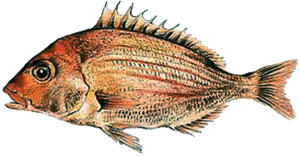Panga facts for kids
Quick facts for kids Panga |
|
|---|---|
 |
|
| Conservation status | |
| Scientific classification | |
| Synonyms | |
|
The panga (Pterogymnus laniarus), also known as the panga seabream, is a type of fish that lives in the ocean. It's part of the Sparidae family, which includes many kinds of seabreams and porgies. The panga is special because it's the only species in its group, called Pterogymnus. You can only find this fish along the coasts of South Africa. It's an important fish for commercial fishing in the area.
Contents
About the Panga Fish
The panga was first officially named Pagrus laniarius in 1830 by a French scientist named Achille Valenciennes. He found it near the Cape of Good Hope in South Africa. Later, in 1938, another scientist, James Leonard Brierley Smith, decided it needed its own special group, Pterogymnus, because it was unique.
What Does Its Name Mean?
The name Pterogymnus comes from two Greek words. "Ptero" means "fin," and "gymnus" means "naked." This refers to how some parts of its fins don't have scales, unlike a similar fish called Cymatoceps. The second part of its name, laniarius, means "butcher" or "related to butchers." The scientist who named it didn't explain why he chose that word.
What Does the Panga Look Like?

The panga has scales between its eyes and on a part of its cheek. Its lower jaw has two rows of teeth that look like human molars. It has two main fins on its back and belly. The fin on its back has 12 stiff spines and 10 soft rays. The fin on its belly has 3 spines and 8 soft rays. The parts of these fins with soft rays don't have scales.
The panga's body is flat from side to side and shaped like an oval. Its body depth is about 2.3 to 2.5 times less than its total length. The top of its head is smoothly curved, and it has large eyes. The fish is usually red or pink, becoming lighter on its belly. It also has 5 or 6 faint bluish lines running horizontally along its sides, below its main side line. Panga fish can grow up to 45 centimeters (about 18 inches) long, but they are usually around 27 centimeters (about 11 inches).
Where Does the Panga Live?
Panga fish are found only in South Africa. They live in the southeastern Atlantic Ocean, from False Bay in the Western Cape, all the way to Beira, Mozambique, in the southwestern Indian Ocean. You can usually find them on deep reefs that have lots of hiding spots. Sometimes, they also live over muddy or sandy areas, as deep as 120 meters (about 390 feet) underwater.
What Does the Panga Eat?
Panga fish are predators, meaning they hunt other creatures for food. Adult panga mostly eat small animals that live on the ocean floor, especially crabs. They also sometimes eat polychaete worms, brittle stars, and smaller fish. Young panga fish, called juveniles, mainly eat tiny shrimp-like creatures called mysids.
Life Cycle and Reproduction
Panga fish are special because their reproductive organs contain both male and female tissues. However, they are "late gonochorists," which means they develop into either male or female as they get older. They become ready to reproduce when they are about 4 or 5 years old. Panga fish mostly lay their eggs near the Agulhas Bank, and they can reproduce throughout the entire year.
Panga and Fishing
The panga is a very important fish for commercial fishing in South Africa. In the southern Eastern Cape, it made up a large part of the fish caught by line fishing between 1985 and 2007. It's also a big part of the fish caught by trawling (using large nets) closer to shore. Between 1992 and 1995, panga made up 63% of the fish caught in the inshore trawl fishery. It also contributes to deep-sea trawl fishing in the southern Eastern Cape and Western Cape.


